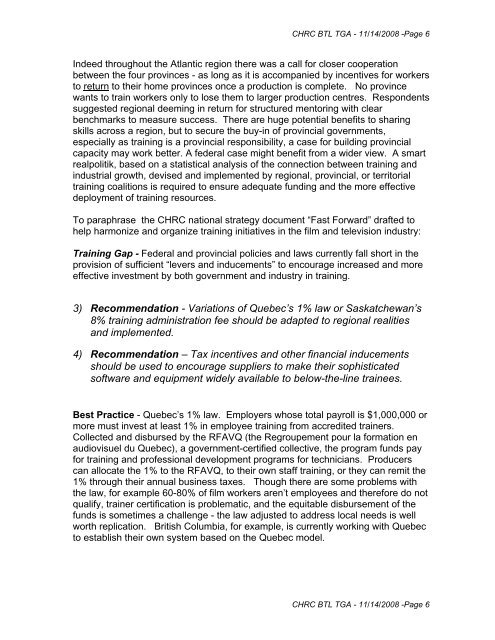Below-the-Line Film and Television Workers - Conseil des ...
Below-the-Line Film and Television Workers - Conseil des ...
Below-the-Line Film and Television Workers - Conseil des ...
- No tags were found...
You also want an ePaper? Increase the reach of your titles
YUMPU automatically turns print PDFs into web optimized ePapers that Google loves.
CHRC BTL TGA - 11/14/2008 -Page 6Indeed throughout <strong>the</strong> Atlantic region <strong>the</strong>re was a call for closer cooperationbetween <strong>the</strong> four provinces - as long as it is accompanied by incentives for workersto return to <strong>the</strong>ir home provinces once a production is complete. No provincewants to train workers only to lose <strong>the</strong>m to larger production centres. Respondentssuggested regional deeming in return for structured mentoring with clearbenchmarks to measure success. There are huge potential benefits to sharingskills across a region, but to secure <strong>the</strong> buy-in of provincial governments,especially as training is a provincial responsibility, a case for building provincialcapacity may work better. A federal case might benefit from a wider view. A smartrealpolitik, based on a statistical analysis of <strong>the</strong> connection between training <strong>and</strong>industrial growth, devised <strong>and</strong> implemented by regional, provincial, or territorialtraining coalitions is required to ensure adequate funding <strong>and</strong> <strong>the</strong> more effectivedeployment of training resources.To paraphrase <strong>the</strong> CHRC national strategy document “Fast Forward” drafted tohelp harmonize <strong>and</strong> organize training initiatives in <strong>the</strong> film <strong>and</strong> television industry:Training Gap - Federal <strong>and</strong> provincial policies <strong>and</strong> laws currently fall short in <strong>the</strong>provision of sufficient “levers <strong>and</strong> inducements” to encourage increased <strong>and</strong> moreeffective investment by both government <strong>and</strong> industry in training.3) Recommendation - Variations of Quebec’s 1% law or Saskatchewan’s8% training administration fee should be adapted to regional realities<strong>and</strong> implemented.4) Recommendation – Tax incentives <strong>and</strong> o<strong>the</strong>r financial inducementsshould be used to encourage suppliers to make <strong>the</strong>ir sophisticatedsoftware <strong>and</strong> equipment widely available to below-<strong>the</strong>-line trainees.Best Practice - Quebec’s 1% law. Employers whose total payroll is $1,000,000 ormore must invest at least 1% in employee training from accredited trainers.Collected <strong>and</strong> disbursed by <strong>the</strong> RFAVQ (<strong>the</strong> Regroupement pour la formation enaudiovisuel du Quebec), a government-certified collective, <strong>the</strong> program funds payfor training <strong>and</strong> professional development programs for technicians. Producerscan allocate <strong>the</strong> 1% to <strong>the</strong> RFAVQ, to <strong>the</strong>ir own staff training, or <strong>the</strong>y can remit <strong>the</strong>1% through <strong>the</strong>ir annual business taxes. Though <strong>the</strong>re are some problems with<strong>the</strong> law, for example 60-80% of film workers aren’t employees <strong>and</strong> <strong>the</strong>refore do notqualify, trainer certification is problematic, <strong>and</strong> <strong>the</strong> equitable disbursement of <strong>the</strong>funds is sometimes a challenge - <strong>the</strong> law adjusted to address local needs is wellworth replication. British Columbia, for example, is currently working with Quebecto establish <strong>the</strong>ir own system based on <strong>the</strong> Quebec model.CHRC BTL TGA - 11/14/2008 -Page 6










